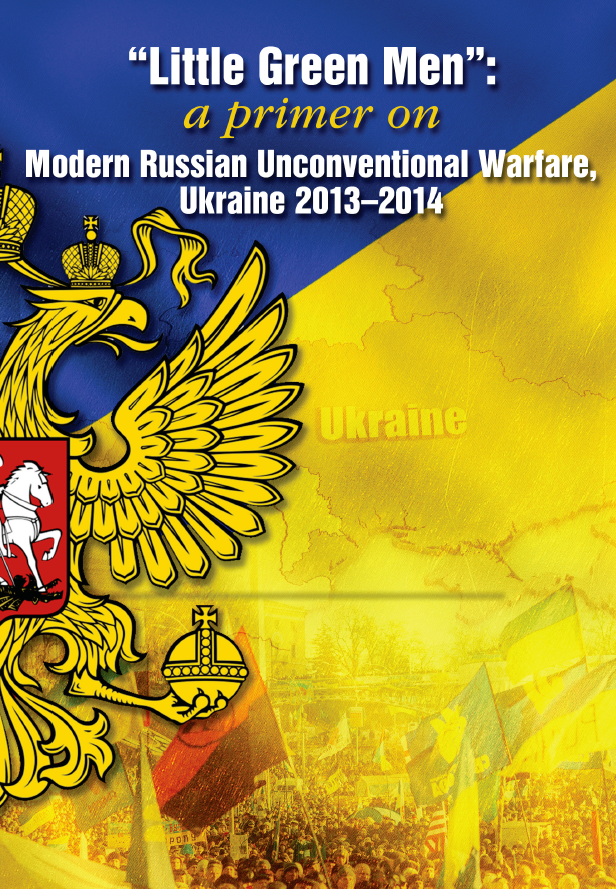This document is intended as a primer—a brief, informative treatment—concerning the ongoing conflict in Ukraine. It is an unclassified expansion of an earlier classified version that drew from numerous classified and unclassified sources, including key US Department of State diplomatic cables. For this version, the authors drew from open source articles, journals, and books. Because the primer examines a very recent conflict, it does not reflect a comprehensive historiography, nor does it achieve in-depth analysis. Instead, it is intended to acquaint the reader with the essential background to and course of the Russian intervention in Ukraine from the onset of the crisis in late 2013 through the end of 2014. The document’s key points are summarized below.
Part I. Context and Theory of Russian Unconventional Warfare
- Key Principles
- Strategy to deal with states and regions on the periphery of the Russian Federation
- Primacy of nonmilitary factors: politics, diplomacy, economics, finance, information, and intelligence
- Primacy of the information domain: use of cyberwarfare, propaganda, and deception, especially toward the Russian-speaking populace
- Persistent (rather than plausible) denial of Russian operations
- Use of unidentified local and Russian agents
- Use of intimidation, bribery, assassination, and agitation
- Start of military activity without war declaration; actions appear to be spontaneous actions of local troops/militias
- Use of armed civilian proxies, self-defense militias, and imported paramilitary units (e.g., Cossacks, Vostok Battalion) instead of, or in advance of, regular troops
- Asymmetric, nonlinear actions
- For the purpose of clarity and uniformity within this study, the authors use the term unconventional warfare to embrace the wide variety of military, informational, political, diplomatic, economic, financial, cultural, and religious activities Russia employed in Ukraine.
- Evolution of Russian unconventional warfare. Russian intervention in Ukraine has featured refined and modernized techniques evolved through observation and analysis of Western methods (the color revolutions, Arab Spring) and Russian experiences since the collapse of the Soviet Union. Specifically, they drew lessons from interventions in:
- Lithuania, 1991
- Transnistria, 1990–1992
- Chechnya (and Dagestan), 1994–1996 (1999–2009)
- Georgia, 2008
- Russian information warfare has emerged as a key component of Russian strategy. Igor Panarin and Alexandr Dugin are the primary theorists.
- Russian Chief of Staff Valery Gerasimov’s model for interstate conflict reflects the growing importance of nonkinetic factors in Russian strategy.
Part II. Russian Unconventional Warfare in Ukraine, 2013–2014
- Historical Context
- Ukraine’s historical, cultural, religious, and economic ties to Russia make it a vital interest to Moscow.
- Western encroachment into the Russian sphere of influence, primarily through North Atlantic Treaty Organization (NATO) expansion and European Union (EU) economic ties, stimulated a reactionary movement among Russian conservatives to stop the loss of peripheral states to the West.
- The Crimean peninsula, with a majority of ethnic Russians, includes Russia’s Black Sea naval base of Sevastopol and is a vital interest to Moscow.
- The Maidan movement is viewed as a product of Western—especially American—conspiracy.
- Vladimir Putin has boosted his popularity by portraying himself as the defender of Russian nationalism and Russian Orthodoxy in Ukraine.
- Russian Tactics, Techniques, and Procedures in Ukraine, 2013–2014
- Political organization within the conflict region to create and sustain pro-Russian political parties, unions, and paramilitary groups
- Recruitment and support of regional SPETSNAZ
- Importation of “little green men”—unidentified Russian agents (usually SPETSNAZ) to organize and lead protests and paramilitary operations
- Importation of Cossack, Chechen, Serbian, and Russian paramilitary “volunteers”
- Persistent (rather than plausible) denial of Russian operations, even in the face of photographic evidence and firsthand testimonials
- Domination of television, radio, and social media through the use of highly trained operatives, including “hacktivists” and seemingly independent bloggers; use of Russia Today television as a highly effective propaganda tool; use of professional actors who portray themselves as pro-Russian Ukrainians
- Use of blackmail, bribery, intimidation, assassination, and kidnapping against regional political opponents and government officials, including police and military officials
- Use of “relief columns” to import weapons, soldiers, equipment, and supplies to pro-Russian forces
- Small-scale invasion and precision operations by conventional Battalion Tactical Groups (BTGs) based along the Russian border
- Issuing Russian passports to pro-Russian populations and touting Moscow’s need to defend the Russian diaspora against alleged abuses
Conclusion
- Driven by a desire to roll back Western encroachment into the Russian sphere of influence, the current generation of Russian leaders has crafted a multidisciplinary art and science of unconventional warfare. Capitalizing on deception, psychological manipulation, and domination of the information domain, their approach represents a notable threat to Western security.
- The new forms of Russian unconventional warfare challenge the structure of the NATO Charter, because they obviate the appearance of “armed invasion.”

